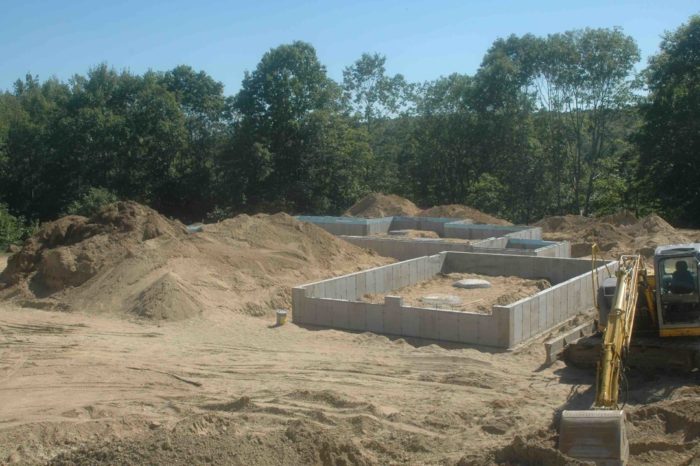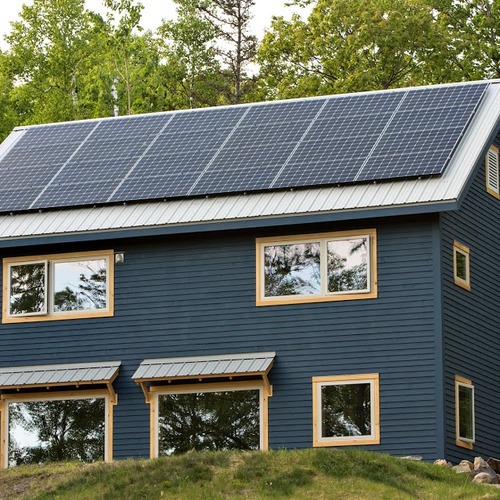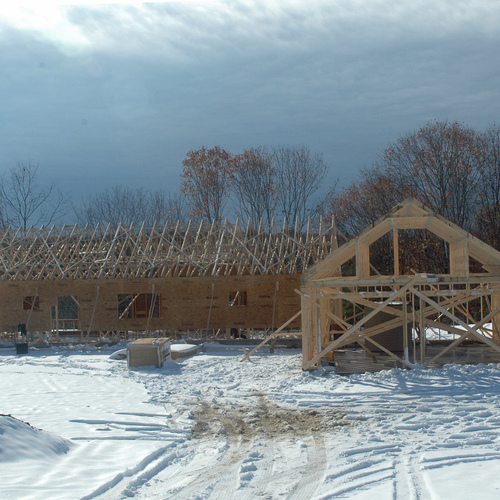
Image Credit: Stephen Sheehy
This is Part 2 of a blog series describing the construction of Stephen Sheehy’s house in Maine. The first installment was titled Pretty Good, Not So Big Maine House.
We’re moving forward with our “pretty good, not so big” house project. We met with our architects and chose our windows. We’re using Intus vinyl windows and doors which represent the best combination of cost and energy efficiency.
We have been playing around with window placement, but are finally ready to order them. Once our architects, Jesse Thompson and Jamie Broadbent, have created a new window/door schedule, all of us will review it and make sure we are ordering what we want, with the right opening direction, etc. The windows and doors are coming from Europe, so we need to do whatever we can to make sure we get what we want. There is a 12-week lead time, so if we want to get the house closed in this fall, we need to act soon.
We are wrestling with various siding options, ranging from traditional white cedar shingles to a much more modern, industrial look: fiber-cement panels from Nichiha. We also are considering fiber-cement clapboards from James Hardie. After we gather quotes and ruminate a bit, we’ll decide.
We got our Maine Department of Transportation (D.O.T.) permit. One of the many things we love about Maine is the relative lack of red tape. I sent in a simple form, staked out where we want the driveway to enter the state road and in less than two weeks, I received the permit in the mail. Plus, it was free! The permit requires us to install a culvert and included a nice detailed drawing of how it should be installed.
Moving some dirt
This week the site subcontractor started work. He rototilled the house and garage footprints and about 20 feet outside of that. Next he’ll stockpile the topsoil and then make the entire area in and around the house flat. Then, he’ll trench for the foundation.
Even though there is no basement, we need a foundation to hold up the house. Here in Maine it is essential that the footing under the foundation be deep enough to get below the winter frost depth of about 4 feet. Otherwise, the frost can literally push the house up and do all sorts of damage. Those frost heaves in our roads in early spring demonstrate the principle.
Last week, I ordered recycled foam insulation to be placed under the concrete slab that will become our finished floor. We’re using 4-inch-thick extruded polystyrene, often simply called XPS. It has an R-value of about 20 (R-5 per inch). It is reclaimed from roofing projects where it is used under commercial flat roofs. We’re also using some 2-inch-thick EPS (expanded polystyrene) which will serve as a thermal break between the vertical foundation and horizontal slab.
There are multiple benefits to using recycled foam insulation. For us, it is a lot cheaper than new insulation. The manufacturing process for XPS releases a tremendous amount of heat-trapping gas that is very damaging to efforts to slow atmospheric warming. By recycling it, instead of using new, we avoid that. We’d never even think of using new XPS. In addition, recycling avoids dumping it into a landfill.
We’re excited about finally starting the project.
We have perfect dirt
Our septic engineer came out to look over the site and lay out for the septic tank and leaching area. Tom Greenleaf, our builder, and I joined him to discuss general location and size. We opted for a two-bedroom design which can be expanded in the future if anyone ever builds an addition.
The engineer located the tank and leach field. He then hand dug a hole about 6 feet deep, periodically reaching in and pulling out a sample of the soil. It turned out that we have nice sand going down at least 6 feet, which is perfect for drainage. Thus, we won’t need any fancy structures for the leaching area, just a stone bed. Since we’re only a few hundred yards from a gravel pit, getting the stone delivered should be pretty cheap.
We also just did a final review of our windows before they get ordered, and went to Maine Green Building Supply to select door and window hardware. We also chose a nice blue color for the exterior of the main entry door. All the other door and window surfaces will be white.
Site work commences
We thought we had selected a pretty level building site, but it turns out we needed to move a lot of dirt. First, the topsoil was scraped off and stockpiled. We’ll use it later for landscaping.
Fortunately, the cuts (soil removal quantities) are roughly equal to the fills (soil additions) so we don’t need to truck material in or out, which can get expensive. Mostly, the subcontractor is moving material around, removing the high spots and filling the low spots. In the end, we need to make sure that the finished grade causes water to flow away from the house, not toward it.
Every house needs a sound foundation
Lots of progress this week. On Monday and Tuesday, the footings were formed and 23 cubic yards of concrete was placed in the forms. The footings are 24 inches by 10 inches in cross-section. They spread the load created by the foundation which supports the house.
Then, on Wednesday, the 8-inch thick frost walls (foundation walls that extend below the winter frost depth of about 4 feet) were formed. On Thursday, another 40 yards of concrete filled the forms. Then on Friday, the forms were stripped.
This morning we met with Daryl, the site subcontractor, to discuss backfilling, perimeter drains, and a retaining wall at the back part of the site, which will allow a flat area off the porch for a future patio. Daryl brought some beautiful stones for the wall he’ll build. They are huge, so he’ll use an excavator to move them around.
Here is a link to Part 3 of this blog series: At a Pretty Good House in Maine, Siding and Septic.
Stephen Sheehy is the author of a construction blog documenting the process of building a Pretty Good House in rural Maine. Over the next several weeks, GBA will publish a serialized and slightly condensed version of Sheehy’s reports. The first installment was published June 15.
Weekly Newsletter
Get building science and energy efficiency advice, plus special offers, in your inbox.















0 Comments
Log in or create an account to post a comment.
Sign up Log in